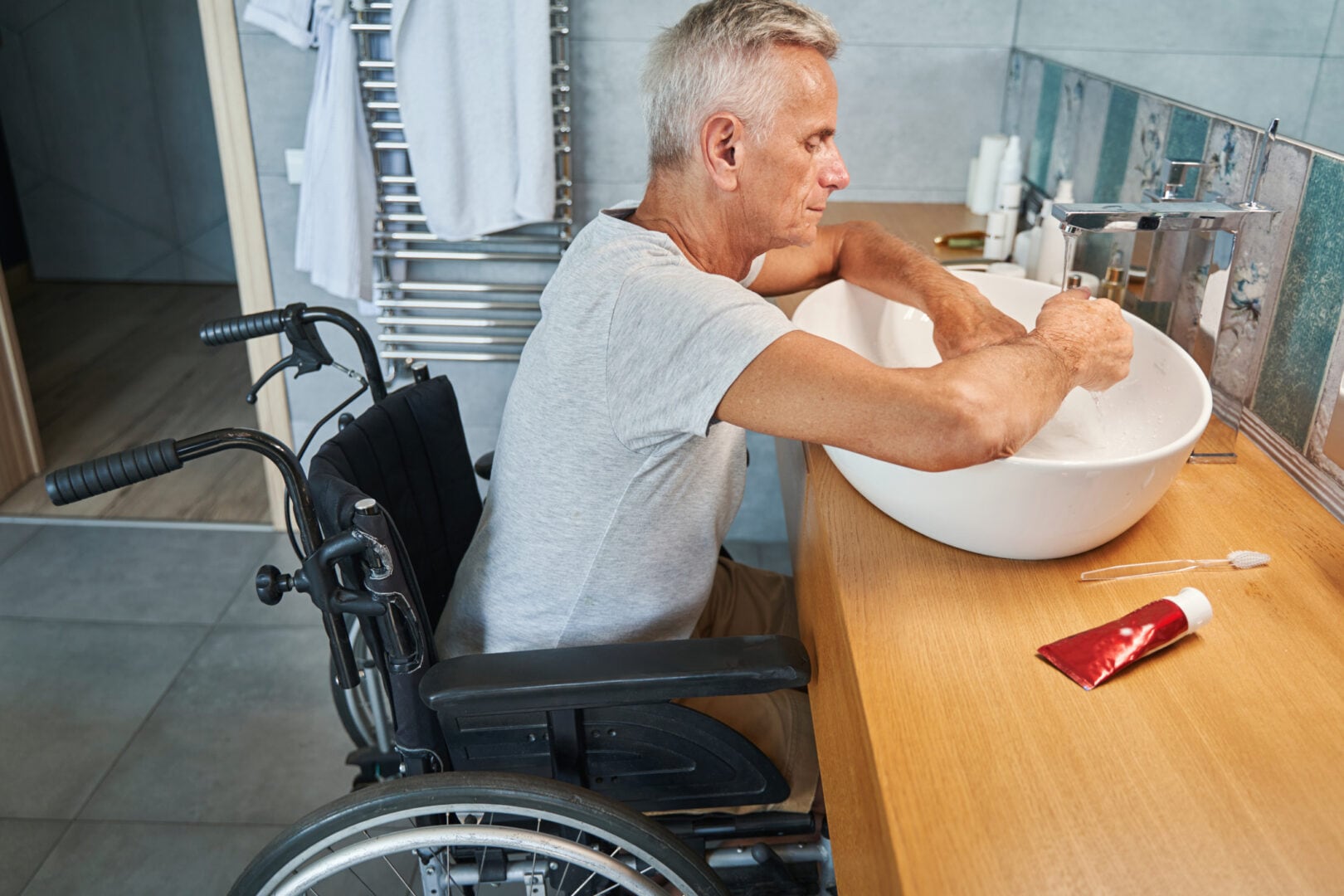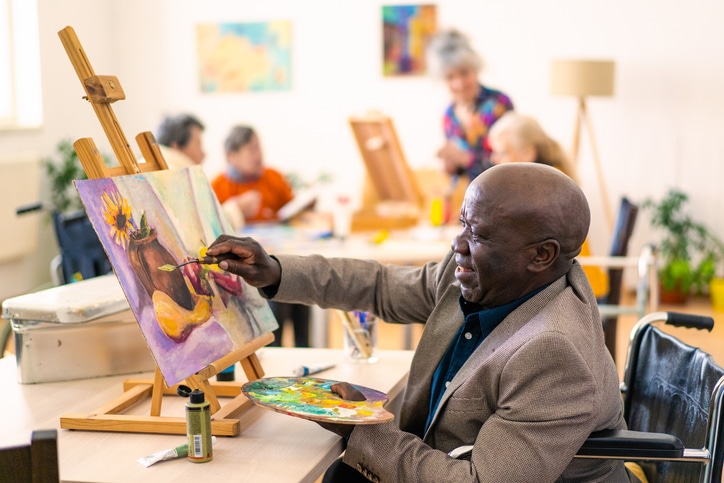For some, the bathroom represents a calming and private escape. From grooming rituals like shaving to self-care activities like soaking in a bubble bath, the bathroom can represent precious alone time. But problems with balance and mobility can quickly turn this haven into a hazard.
“Bathrooms are particularly challenging from a safety and comfort perspective,” says Jamie Gold, a certified aging in place specialist and wellness design consultant in San Diego. “Older adults are most at risk of a slip and fall, and most often, seriously harmed by these accidents. The combination of brittle bones, poor balance and wet, brittle floor tile can be literally deadly.”
So, what can you do when a loved one’s age or declining health raises their risk of bathroom injuries? Below, Gold and several health experts offer tips and advice for a bathroom remodel for seniors.
Bathroom designs for seniors
When creating an accessible bathroom for older adults, it’s important to have their particular needs and abilities in mind. “Each person is going to have unique needs based on their endurance, strength, range of motion and the type of mobility aid they are using,” notes Tamzyn Mather, an occupational therapist at Northwestern Medicine Central DuPage Hospital in Winfield, Illinois.
Here, tips to create an accessible bathroom for seniors of varying physical and cognitive abilities.
Cane- or walker-accessible bathrooms
- Remove tripping hazards. These might include throw rugs, trash cans and any decorative items on the floor.
- Add suction-cup grab bars or install permanent grab bars. Bars should be placed next to the shower entrance and inside the shower, facing the faucet.
- Place a non-slip mat in the shower.
- Raise the toilet seat. Raised toilet seats can be installed directly onto any standard toilet bowl.
- Add a frame around the toilet. Stand-alone toilet frames can be adjusted to fit snugly around any toilet.
- Get a shower chair or transfer bench. Buy a shower chair for walk-in showers or a transfer bench for bathtubs, suggests Yen Le, an occupational therapist at Marianjoy Rehabilitation Hospital in Wheaton, Illinois.
- Install a handheld showerhead. This makes it possible to shower in a seated position.
- Add a night light. Add a night light, use brighter bulbs or simply leave the bathroom light on at all times.
Bathrooms for older adults with limited arm and hand mobility
- Install motion-activated lights. These are particularly important fo seniors who use walkers or canes, Le notes.
- Get a bidet.
- Put a long-handled sponge in the shower.
- Provide an electric toothbrush.
- Keep wipes handy.
- Try automatic soap and toothpaste dispensers.
- Consider new faucet controls. Install sensor-activated faucets or make sure sink and shower controls are lubricated enough for someone with hand weakness, notes Melissa Prestipino, owner of Maize & Blue Rehab in Sparta, New Jersey. .
Bathroom remodel for seniors with vision impairment
- Aim for a high-contrast color scheme. “If everything is bright white, it may be hard to see where the toilet, tub wall or shower start,” says Le. She suggests painting in high-contrast colors and avoiding high-gloss finishes, which create glare.
- Brighten the lights.
- Get a magnified mirror.
Wheelchair-accessible bathrooms
“ADA guidelines are a good rule of thumb, but it’s more important to account for the individual’s abilities, height and even body size when considering home bathroom accessibility,” says Mather. ADA basics include:
- Wider doorways (a minimum of 32 inches of clearance).
- Door hardware that can be operated with one hand and that does not require wrist twisting.
- Lowered thresholds (no higher than 1/2 inch tall).
Kathrina Prostka and Barbara Peraino, both wheelchair seating and positioning specialists at Marianjoy Rehabilitation Hospital, suggest the following for making a bathroom wheelchair-accessible:
- Consider removing or changing the door. If renovating the doorway is possible, choose a sliding barn door or pocket door to give as much clearance as possible for your loved one’s wheelchair. If that doesn’t work with your budget, consider swapping the door for a shower curtain or other sliding covering.
- Remove the threshold. Getting rid of the threshold of installing a threshold ramp will make it easier for someone in a wheelchair to roll into the bathroom.
- Place hygiene and grooming items toward the front.
- Get an angled mirror.
- Remove the cabinet door under the sink. If you’re unable to install a wheelchair-friendly sink vanity, consider removing the bottom cabinet door. This allows the wheelchair user’s legs to fit under the sink to better reach the flow of water.
What to do before creating an accessible bathroom
Before doing a complete bathroom overhaul, here are a few things to consider:
- Take the future into account. If your loved one has a degenerative disease such as Parkinson’s, osteoarthritis or ALS, your current bathroom accessibility plan might not work in few months. It’s important to keep both the present and future in mind — not just for the bathroom itself, but for the budget. Le suggests leaving room in the budget for accessibility features such as a transfer bench or sliding bathroom door that might become necessary in the future.
- Work as a team. Just because an older adult has physical limitations, it doesn’t mean they have cognitive limitations. Therefore, whenever possible, include them in the bathroom modification planning. “Independence gives seniors a sense of purpose,” reminds Le.
- Take inventory. Creating an accessible bathroom can get expensive. Be sure to explore other rooms for potential mobility aids. Maybe you already own high-watt lightbulbs that could brighten the bathroom. Maybe the non-slip floor mat in front of the kitchen sink could be moved in front of the toilet instead. There’s nothing wrong with making use of what you have in the house already. Le also suggests looking for a medical equipment loan program in your area. A local physical therapist or occupational therapist can help point you in the right direction.
The bottom line
It’s not possible to predict what the future holds for your aging loved one’s mobility. What caregivers can assume, however, is that seniors who want to age in place should prepare for additional safety and accessibility needs as they age. In the long-run, putting in the effort to create a safer, more accessible bathroom for them will be well worth the effort.


